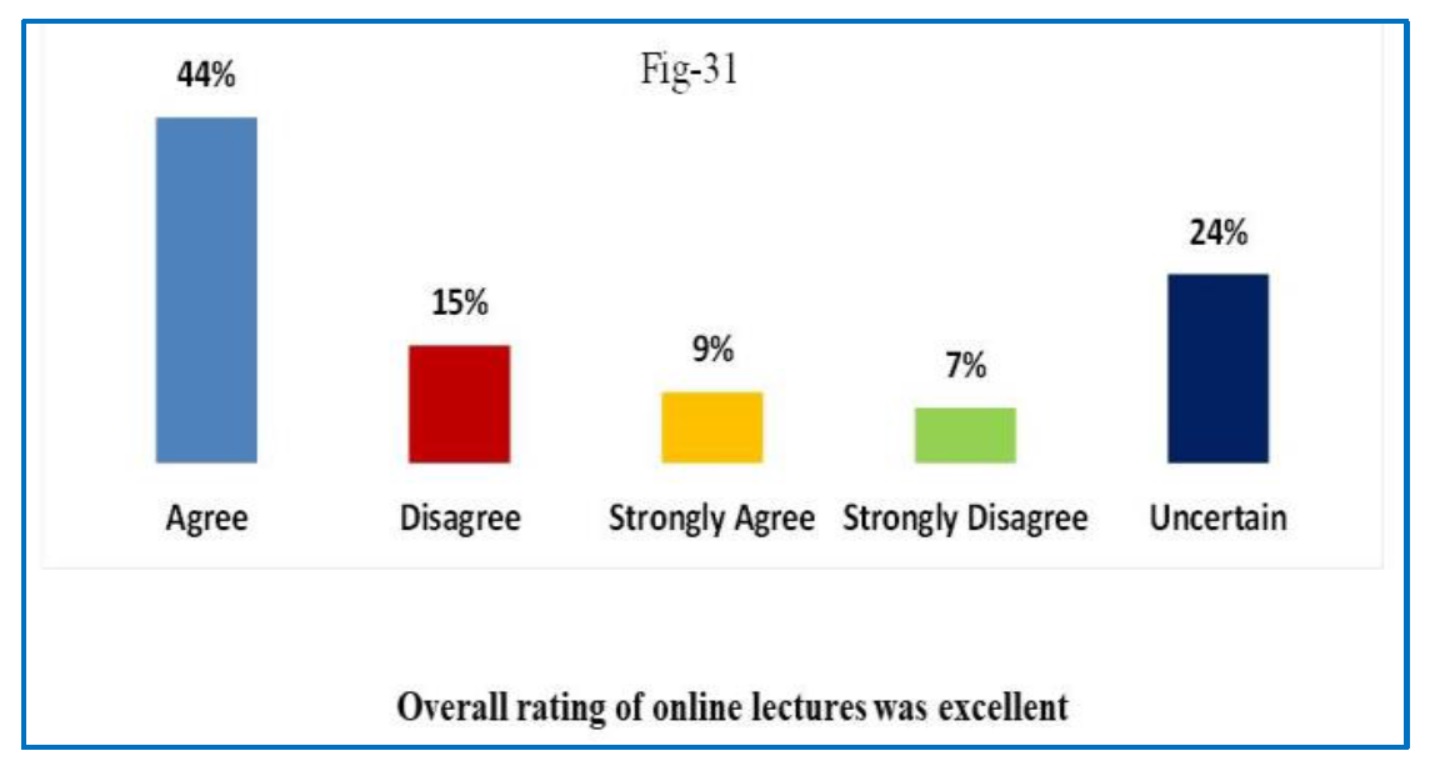Student perception of Online Teaching in HEI during COVID-19 Pandemic : A Survey Study
Keywords:
Covid 19, Pandemic, Online Teaching, HEI, Student perception, Online learning, Online educationAbstract
The COVID 19 pandemic has strangulated the educational sector. The current study was aimed to know the student perception of online teaching in Higher Education Institute (HEI) during COVID 19 pandemic. This study hence brings about required modifications to deliver knowledge effectively in this current crisis. An online survey was conducted among the students of Higher Education Institute (HEI). As part of this process, validated questionnaire was sent to 4982 students. 60 percent (2986) students responded to them. Questionnaire included 11 domains and 26 items or sub domains related to online teaching. Study found majority of students choosing smart phones as preferred device for learning. There were varied opinions regarding connectivity. Students were satisfied with the quality of online classes delivered. Microsoft Teams was suggested by students as a better platform to learn than other online platforms. Study hence mentions more smart phone based educational applications and learning platforms to be prepared along with smart phone run digital repositories, etc. The study only could furnish response from 60percent student population of HEI; the survey was based on one month online teaching schedule. In study, limited online platforms were only used and individual features of online platforms were utilized not mentioned.
Downloads
References
Dadax limited. (2008). Worldometer. Retrieved 25 December, 2020, from https://www.worldometers.info/world-population/india-population/
India brand equity foundation. (2003). India Brand Equity Foundation's website. Retrieved 25 December, 2020, from https://www.ibef.org/industry/education-sector-india.aspx
United States Census Bureau. (1902). United States Census Bureau's website. Retrieved 25 December, 2020, from https://www.census.gov/popclock/
India Brand Equity Foundation. (2003). India Brand Equity Foundation's website. Retrieved 25 December, 2020, from https://www.ibef.org/industry/education-sector-india.aspx#login-box
Ministry of education, Government of India (2010). All India Survey on Higher Education. Retrieved 25 December, 2020, from http://aishe.nic.in/aishe/home
India brand equity foundation. (2003). India Brand Equity Foundation's website. Retrieved 25 December, 2020, fromhttps://www.ibef.org/industry/education-sector-india.aspx
World health organization. (1984). World Health Organization's website. Retrieved 25 December, 2020, from https://www.who.int/news/item/27-04-2020-who-timeline---covid-19
British Broadcasting Corporation. (1969). BBC News' website. Retrieved 25 December, 2020, from http://news.bbc.co.uk/2/hi/south_asia/6911544.stm
Jena, P. K. (2020). Impact of Pandemic COVID - 19 on Education in India. International Journal of Current Research, 12(7), 12582-12586.
Conly, J et al. (2014). Infection prevention and control of epidemic-and pandemic-prone acute respiratory infectionsin health care. Retrieved 25 December, 2020, from https://apps.who.int/iris/bitstream/handle/10665/112656/9789241507134_eng.pdf?sequence=1
Liu et al. (2020). Community Transmission of Severe Acute Respiratory Syndrome Coronavirus 2, Shenzhen, China, 2020. Emerging Infectious Diseases, 26(6), 1320-1323. Retrieved 25 December, 2020, from https://www.ncbi.nlm.nih.gov/pmc/articles/PMC7258448/pdf/20-0239.pdf
Woo chan et al. (2020). A familial cluster of pneumonia associated with the 2019 novel coronavirus indicating person-to-person transmission: a study of a family cluster. Lancet, 395(10223), 514-523. Retrieved 25 December, 2020, from https://www.thelancet.com/pdfs/journals/lancet/PIIS0140-6736(20)30154-9.pdf
Li et al. (2020). Early Transmission Dynamics in Wuhan, China, of Novel Coronavirus–Infected Pneumonia. The New England Journal of Medicine, 382(13), 1199-1207. Retrieved 25 December, 2020, from https://www.nejm.org/doi/pdf/10.1056/NEJMoa2001316?articleTools=true
Huang et al. (2020). Clinical features of patients infected with 2019 novel coronavirus in Wuhan, China. Lancet, 395(10223), 497-506. Retrieved 25 December, 2020, from https://www.thelancet.com/action/showPdf?pii=S0140-6736%2820%2930183-5
Burke et al. (2020). Morbidity and Mortality Weekly ReportMMWR/March 6, 2020/Vol 69/No 9245US Department of Health and Human Services/Centers for Disease Control and PreventionActive Monitoring of Persons Exposed to Patients with Confirmed COVID-19 — United States, January–February 2020. Morbidity and Mortality Weekly Report, 69(9), 245-246. Retrieved 25 December, 2020, from https://www.ncbi.nlm.nih.gov/pmc/articles/PMC7367094/pdf/mm6909e1.pdf
World health organization. (2020). World Health Organization's website. Retrieved 26 December, 2020, from https://www.who.int/docs/default-source/coronaviruse/who-china-joint-mission-on-covid-19-final-report.pdf
Ugcnetpaper1 team. (2020). Notes on different teaching techniques for UGC NET exam. [Weblog]. Retrieved 26 December 2020, from https://ugcnetpaper1.com/teaching-methodology/
Ministry of Human Resource Development. (2020). Ministry of Human Resource Development's website. Retrieved 26 December, 2020, from https://www.education.gov.in/sites/upload_files/mhrd/files/NEP_Final_English_0.pdf
Press Information Bureau. (2020). Press Information Bureau's website. Retrieved 26 December, 2020, from https://pib.gov.in/PressReleasePage.aspx?PRID=1620136
Ministry of education. (2020). Ministry of Education's website. Retrieved 26 December, 2020, from https://www.education.gov.in/sites/upload_files/mhrd/files/inccu_0.pdf
Ruiz et al. (2006). The Impact of E-Learning in Medical Education. Academic Medicine, 81(3), 207-212. Retrieved 26 December, 2020, from https://journals.lww.com/academicmedicine/Fulltext/2006/03000/The_Impact_of_E_Learning_in_Medical_Education.2.aspx
Chen, X, Bai, X & Xiao, Y. (2017). The Application of E-learning in Maritime Education and Training in China. Trans Nav, 11(2), 349-354. Retrieved 26 December, 2020, from https://www.researchgate.net/publication/318335798_The_Application_of_E-learning_in_Maritime_Education_and_Training_in_China
Priyadershini, S. (2020). The Hindu's website, Our guide to India-made video-conferencing apps . Retrieved 26 December, 2020, from https://www.thehindu.com/sci-tech/technology/video-conferencing-chatting-apps-made-in-india-2020/article32266494.ece
Tsang, S, Royse, C. F & Terkawi, A. S. (2017). Guidelines for developing, translating, and validating a questionnaire in perioperative and pain medicine. Saudi Journal of Anaesthesia, 11(1), 80-89. Retrieved 26 December, 2020, from https://www.ncbi.nlm.nih.gov/pmc/articles/PMC5463570/
Roberts, N & Rees, M. (2014). Student use of mobile devices in university lectures. Australasian Journal of Educational Technology, 30(4), 415-426. Retrieved 27 December, 2020, from https://www.researchgate.net/publication/298418449_Student_use_of_mobile_devices_in_university_lectures
Statista. (2007). Statista's website. Retrieved 27 December, 2020, from https://www.statista.com/statistics/467163/forecast-of-smartphone-users-in-india/
Gadgets 360. (2013). Gadgets 360's website. Retrieved 27 December, 2020, from https://gadgets.ndtv.com/mobiles/news/70-percent-students-use-smartphone-in-india-survey-381068
Statista. (2007). Statista's website. Retrieved 27 December, 2020, from https://www.statista.com/topics/2157/internet-usage-in-india/
Catherine Hoffman Kaser. (1930). Old Dominion University's website. Retrieved 27 December, 2020, from https://www.odu.edu/content/dam/odu/col-dept/cdse/docs/2-classroom-schedules.pdf
Servilha & Costa. (2015). Knowledge about voice and the importance of voice as an educational resource in the perspective of university professors. Revista CEFAC, 17(1), 13-26. Retrieved 27 December, 2020, from https://www.scielo.br/scielo.php?script=sci_arttext&pid=S1516-18462015000100013&lng=en&nrm=iso&tlng=en
Kaur, M. (2013). Blended learning - its challenges and future. Procedia - Social and Behavioral Sciences, 93(1), 612-617. Retrieved 27 December, 2020, from https://www.researchgate.net/publication/270848668_Blended_Learning_-_Its_Challenges_and_Future















